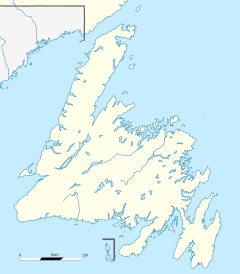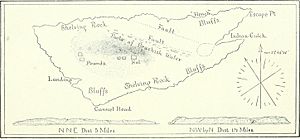Funk Island facts for kids
Funk Island is a small, lonely island far off the coast of Newfoundland and Labrador, Canada. It's about 60 kilometers (37 miles) northeast of a town called Wesleyville. This island is uninhabited, meaning no people live there. It's famous for being a very important home for millions of seabirds.
Contents
Island Features
Funk Island is shaped a bit like a trapezoid. It's not very big, only about 0.8 kilometers (0.5 miles) long and 0.3 kilometers (0.2 miles) wide. The island is mostly flat, rising about 14 meters (46 feet) out of the North Atlantic.
The island is made of a type of rock called granite. It has two big cracks, called fault lines, that run across it. These faults divide the island into three parts. The northeast part is mostly bare rock. The middle part has some plants growing here and there. The largest part, the southwest, is covered with grasses, lichens, and mosses.
It's very tricky and dangerous to land on Funk Island. However, on calm days, there are three spots where boats can safely land. These spots include Gannet Head and Landing Rock on the southwest side. On the north side, there's a steep cliff with a natural shelf called The Bench. This shelf makes it a bit easier to get onto the island.
The cold Labrador Current flows past Funk Island. This current brings lots of cold-water fish, which are a perfect food source for the many seabirds that live and breed on the island. When the tide is high, waves crash against the cliffs. During very high seas, waves can even break over the entire island.
There are also two large rock formations near the southwest side of the island. These rocks are often covered by the sea. They are used by many seabirds, especially gannets, as resting spots, but not for nesting. The island and these two rock formations together are known as the "Funks."
Even though many ships have been wrecked and lives lost in the area, there are no lighthouses or other navigation aids on Funk Island.
Island History
The name "Funk" means a bad smell or vapor. People think the island got this name because of the strong, unpleasant smell there. This smell comes from the huge amounts of bird droppings, called guano, that have built up over centuries. These droppings contain chemicals like nitrates and phosphates.
Some people believe the name might come from an old Norse or Icelandic word for a "haycock" (a pile of hay), which the island might have looked like. However, this idea seems unlikely because the name Funk didn't appear on maps until the late 1700s. Before that, sailors often called it Penguin Island.
It's thought that Gaspar Corte-Real visited the island in 1501. Soon after, maps started showing it as "Island of Birds." Many explorers and fishing groups visited the "Island of Penguin" or "I des Penguins" because of the huge number of birds. For example, James Cook's 1775 map shows it as Funk Island. In 1534, Jacques Cartier also mentioned the many birds and even polar bears on Funk Island.
The island was probably called Penguin Island because the great auk used to nest there by the thousands, or even tens of thousands. This continued until the late 1700s, when their numbers dropped very quickly. Interestingly, some people think the word "penguin" itself might have come from the name of this island. The word "penguin" may come from a Breton language phrase meaning "white head."
The Sad Story of the Great Auk
It's believed that people visited Funk Island shortly after the first native peoples settled in Newfoundland. For example, in 1766, Joseph Banks learned that the Beothuk people made a type of pudding from eggs they collected from Penguin (Funk) Island. The great auk was also known as the garefowl.
In the early 1500s, European sailors came to Newfoundland to fish for cod. After long journeys across the ocean, they needed fresh meat. They quickly realized how easy it was to catch the auks on Funk Island. Many explorers and fishing groups came to the Funks to get seabirds for food and oil for their lamps. The great auks were birds that couldn't fly, which made them very easy to catch.
By 1578, hundreds of Spanish, French, and English ships were fishing nearby. Later, settlers living along the northeast coast of Newfoundland often made the short trip to the Funks. They killed birds for food and lamp oil. They also used the feathers for pillows and mattresses and collected the eggs to eat.
In 1622, Sir Richard Whitbourne wrote about how the birds were simply herded up gang planks into the boats. He said it was "as if God had made the innocence of so poor a creature to become such an admirable instrument for the sustenance of man."
Scientific Expeditions and Protection
By 1800, the great auk was likely extinct on Funk Island. By 1844, it was extinct everywhere in the world.
After the great auk disappeared, scientists became very interested in learning more about them. In 1841, a Norwegian scientist named Dr. Peter Stuvitz tried to visit Funk Island to find specimens of the birds, but bad weather stopped him.
The next scientific visit happened in 1863. Thomas Molloy, a United States Consul, got permission to go to Funk Island to dig up remains of the great auk. His team collected 35 tons of decomposed bird material. Some of it was sold locally, and 30 tons were shipped to American cities like Boston and Washington D.C. There, it was used to fertilize gardens.
In 1873, John Milne, a naturalist, visited the island. He managed to find parts of skeletons and other bones. He reported that there were many terns on Funk Island, but the murre and razorbill populations had been almost destroyed by people collecting their eggs. In just one hour, during a dangerous landing, Milne found the skeletal remains of at least 50 birds in a small grassy area. His collection of great auk skeletons later went to various museums.
The most successful early scientific trip to Funk Island was in 1887. It was led by Frederick A. Lucas from the United States Fish Commission. His team found that about a quarter of the island's surface was covered with earth containing eggshells and granite pebbles. They dug up many more skeletons for scientific study.
This expedition also collected rock samples. They found several rusted iron kettles, which they believed were used to scald the great auks to make it easier to remove their feathers. Near where the auks used to breed, they discovered enclosures made of granite blocks. It's thought that the auks were herded into these areas to make killing them easier.
Many other expeditions have visited Funk Island since then, up until 1982. In 1964, the island became a Provincial Wildlife Sanctuary. This meant that landing there was not allowed without a special permit. Because of this protection, the bird population began to recover. Today, researchers from Memorial University and Environment and Climate Change Canada monitor the birds.
Breeding Colonies
Eleven different types of marine birds have been known to breed on Funk Island:
- Great auk (now extinct)
- Arctic tern
- Northern gannet
- Northern fulmar
- Great black-backed gull
- Herring gull
- Black-legged kittiwake
- Razorbill
- Thick billed murre
- Atlantic puffin
- Common murre
In 1972, the largest bird population on Funk Island was the thin-billed or common murre. There were 396,461 pairs of them! That number was 80% of all the breeding common murres in eastern North America. This makes Funk Island one of the most important seabird colonies in the world. By 1982, the total seabird population on Funk Island was estimated to be over 1,000,000 birds.



